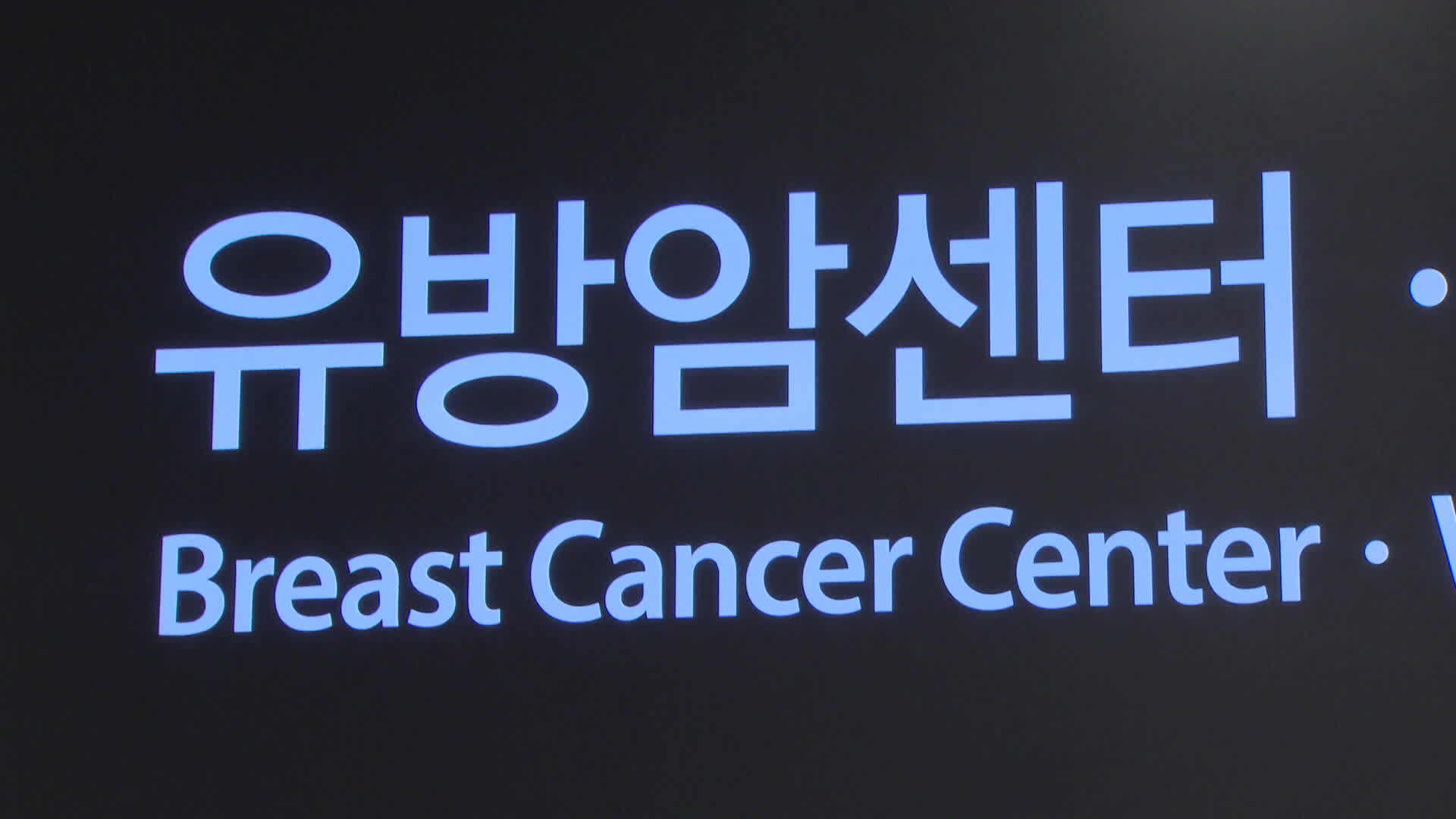[Anchor]
Breast cancer is the most common cancer among middle-aged women in our country.
Have you heard of 'breast carcinoma in situ'? It literally means that the cancer is confined in one place, referring to the stage before it spreads to the surrounding area.
Recently, it has been reported that the number of carcinoma in situ patients has surged, raising questions about what this signals and how to respond. Jin Sun-min reports.
[Report]
This woman was diagnosed with 'breast carcinoma in situ,' commonly referred to as stage 0 cancer, two years ago.
If a tumor had not been detected during her company's health check-up, it might have gone unnoticed.
[Ms. A/50s breast carcinoma in situ patient: "I had a health check-up at work, and they said, 'There seems to be something wrong.' I didn't have any external symptoms or pain."]
Carcinoma in situ is an early stage where cancer cells have developed but have not spread to the surrounding areas.
While it is relatively low-risk, if left untreated, it can progress to invasive cancer.
[Baek Se-hyun/Director of the Breast Center at Ewha Womans University Medical Center: "You can think of it as being at the stage just before fully entering cancer. Depending on the characteristics of the in situ breast cancer tissue, there may be differences in timing, but it is expected to progress eventually."]
As of 2023, there are over 39,000 middle-aged women diagnosed with breast carcinoma in situ.
This marks a 43% increase over four years, making it the highest growth rate among all diseases in the middle-aged demographic, according to data compiled by KBS.
During the same period, the number of elderly patients has nearly doubled.
Excessive exposure to female hormones, obesity, and family history are cited as major risk factors for breast carcinoma in situ, but the exact causes of the disease are still unclear.
Given the limitations in prevention, 'early detection' is crucial.
Especially from the age of 40, it is advisable to undergo CT or MRI scans every 1 to 2 years, even if there are no symptoms.
Even if a tumor is detected, most cases can be treated with surgery, but continuous monitoring is necessary.
[Ms. B/50s breast carcinoma in situ patient: "They said I need to take medication for five years. After all, cancer cells have been found. That means they could spread to other areas..."]
If the cancer continues to progress, it is classified from stage 1 to stage 4, depending on the size of the tumor or whether it has spread to other organs.
Even including stage 4, where cancer has metastasized to other organs, the survival rate for the five years period for breast cancer patients is 94%, which is relatively high compared to other cancers.
[Lee Si-yeon/Director of the Breast Cancer Center at the National Cancer Center: "Even at stage 4, the treatments have improved so much that if the metastasis is well controlled through medication, there may be opportunities to perform surgery on the breast itself."]
However, there are cases where cancer recurs after 10 years post-surgery, so it is important to maintain a mindset of 'no complete cure' and manage it for life.
[Choi Jeong-ye/40s stage 2 breast cancer patient: "It's something that's happened to me, so I try to approach treatment with a positive attitude, and I always aim to walk more than 10,000 steps every day."]
Research has shown that if weight increases by more than 10% after a breast cancer diagnosis, the risk of cardiovascular disease increases by 66%.
This is Jin Sun-min from KBS News.
Breast cancer is the most common cancer among middle-aged women in our country.
Have you heard of 'breast carcinoma in situ'? It literally means that the cancer is confined in one place, referring to the stage before it spreads to the surrounding area.
Recently, it has been reported that the number of carcinoma in situ patients has surged, raising questions about what this signals and how to respond. Jin Sun-min reports.
[Report]
This woman was diagnosed with 'breast carcinoma in situ,' commonly referred to as stage 0 cancer, two years ago.
If a tumor had not been detected during her company's health check-up, it might have gone unnoticed.
[Ms. A/50s breast carcinoma in situ patient: "I had a health check-up at work, and they said, 'There seems to be something wrong.' I didn't have any external symptoms or pain."]
Carcinoma in situ is an early stage where cancer cells have developed but have not spread to the surrounding areas.
While it is relatively low-risk, if left untreated, it can progress to invasive cancer.
[Baek Se-hyun/Director of the Breast Center at Ewha Womans University Medical Center: "You can think of it as being at the stage just before fully entering cancer. Depending on the characteristics of the in situ breast cancer tissue, there may be differences in timing, but it is expected to progress eventually."]
As of 2023, there are over 39,000 middle-aged women diagnosed with breast carcinoma in situ.
This marks a 43% increase over four years, making it the highest growth rate among all diseases in the middle-aged demographic, according to data compiled by KBS.
During the same period, the number of elderly patients has nearly doubled.
Excessive exposure to female hormones, obesity, and family history are cited as major risk factors for breast carcinoma in situ, but the exact causes of the disease are still unclear.
Given the limitations in prevention, 'early detection' is crucial.
Especially from the age of 40, it is advisable to undergo CT or MRI scans every 1 to 2 years, even if there are no symptoms.
Even if a tumor is detected, most cases can be treated with surgery, but continuous monitoring is necessary.
[Ms. B/50s breast carcinoma in situ patient: "They said I need to take medication for five years. After all, cancer cells have been found. That means they could spread to other areas..."]
If the cancer continues to progress, it is classified from stage 1 to stage 4, depending on the size of the tumor or whether it has spread to other organs.
Even including stage 4, where cancer has metastasized to other organs, the survival rate for the five years period for breast cancer patients is 94%, which is relatively high compared to other cancers.
[Lee Si-yeon/Director of the Breast Cancer Center at the National Cancer Center: "Even at stage 4, the treatments have improved so much that if the metastasis is well controlled through medication, there may be opportunities to perform surgery on the breast itself."]
However, there are cases where cancer recurs after 10 years post-surgery, so it is important to maintain a mindset of 'no complete cure' and manage it for life.
[Choi Jeong-ye/40s stage 2 breast cancer patient: "It's something that's happened to me, so I try to approach treatment with a positive attitude, and I always aim to walk more than 10,000 steps every day."]
Research has shown that if weight increases by more than 10% after a breast cancer diagnosis, the risk of cardiovascular disease increases by 66%.
This is Jin Sun-min from KBS News.
■ 제보하기
▷ 카카오톡 : 'KBS제보' 검색, 채널 추가
▷ 전화 : 02-781-1234, 4444
▷ 이메일 : kbs1234@kbs.co.kr
▷ 유튜브, 네이버, 카카오에서도 KBS뉴스를 구독해주세요!
- Breast cancer (carcinoma in situ)
-
- 입력 2025-05-11 02:48:00

[Anchor]
Breast cancer is the most common cancer among middle-aged women in our country.
Have you heard of 'breast carcinoma in situ'? It literally means that the cancer is confined in one place, referring to the stage before it spreads to the surrounding area.
Recently, it has been reported that the number of carcinoma in situ patients has surged, raising questions about what this signals and how to respond. Jin Sun-min reports.
[Report]
This woman was diagnosed with 'breast carcinoma in situ,' commonly referred to as stage 0 cancer, two years ago.
If a tumor had not been detected during her company's health check-up, it might have gone unnoticed.
[Ms. A/50s breast carcinoma in situ patient: "I had a health check-up at work, and they said, 'There seems to be something wrong.' I didn't have any external symptoms or pain."]
Carcinoma in situ is an early stage where cancer cells have developed but have not spread to the surrounding areas.
While it is relatively low-risk, if left untreated, it can progress to invasive cancer.
[Baek Se-hyun/Director of the Breast Center at Ewha Womans University Medical Center: "You can think of it as being at the stage just before fully entering cancer. Depending on the characteristics of the in situ breast cancer tissue, there may be differences in timing, but it is expected to progress eventually."]
As of 2023, there are over 39,000 middle-aged women diagnosed with breast carcinoma in situ.
This marks a 43% increase over four years, making it the highest growth rate among all diseases in the middle-aged demographic, according to data compiled by KBS.
During the same period, the number of elderly patients has nearly doubled.
Excessive exposure to female hormones, obesity, and family history are cited as major risk factors for breast carcinoma in situ, but the exact causes of the disease are still unclear.
Given the limitations in prevention, 'early detection' is crucial.
Especially from the age of 40, it is advisable to undergo CT or MRI scans every 1 to 2 years, even if there are no symptoms.
Even if a tumor is detected, most cases can be treated with surgery, but continuous monitoring is necessary.
[Ms. B/50s breast carcinoma in situ patient: "They said I need to take medication for five years. After all, cancer cells have been found. That means they could spread to other areas..."]
If the cancer continues to progress, it is classified from stage 1 to stage 4, depending on the size of the tumor or whether it has spread to other organs.
Even including stage 4, where cancer has metastasized to other organs, the survival rate for the five years period for breast cancer patients is 94%, which is relatively high compared to other cancers.
[Lee Si-yeon/Director of the Breast Cancer Center at the National Cancer Center: "Even at stage 4, the treatments have improved so much that if the metastasis is well controlled through medication, there may be opportunities to perform surgery on the breast itself."]
However, there are cases where cancer recurs after 10 years post-surgery, so it is important to maintain a mindset of 'no complete cure' and manage it for life.
[Choi Jeong-ye/40s stage 2 breast cancer patient: "It's something that's happened to me, so I try to approach treatment with a positive attitude, and I always aim to walk more than 10,000 steps every day."]
Research has shown that if weight increases by more than 10% after a breast cancer diagnosis, the risk of cardiovascular disease increases by 66%.
This is Jin Sun-min from KBS News.
Breast cancer is the most common cancer among middle-aged women in our country.
Have you heard of 'breast carcinoma in situ'? It literally means that the cancer is confined in one place, referring to the stage before it spreads to the surrounding area.
Recently, it has been reported that the number of carcinoma in situ patients has surged, raising questions about what this signals and how to respond. Jin Sun-min reports.
[Report]
This woman was diagnosed with 'breast carcinoma in situ,' commonly referred to as stage 0 cancer, two years ago.
If a tumor had not been detected during her company's health check-up, it might have gone unnoticed.
[Ms. A/50s breast carcinoma in situ patient: "I had a health check-up at work, and they said, 'There seems to be something wrong.' I didn't have any external symptoms or pain."]
Carcinoma in situ is an early stage where cancer cells have developed but have not spread to the surrounding areas.
While it is relatively low-risk, if left untreated, it can progress to invasive cancer.
[Baek Se-hyun/Director of the Breast Center at Ewha Womans University Medical Center: "You can think of it as being at the stage just before fully entering cancer. Depending on the characteristics of the in situ breast cancer tissue, there may be differences in timing, but it is expected to progress eventually."]
As of 2023, there are over 39,000 middle-aged women diagnosed with breast carcinoma in situ.
This marks a 43% increase over four years, making it the highest growth rate among all diseases in the middle-aged demographic, according to data compiled by KBS.
During the same period, the number of elderly patients has nearly doubled.
Excessive exposure to female hormones, obesity, and family history are cited as major risk factors for breast carcinoma in situ, but the exact causes of the disease are still unclear.
Given the limitations in prevention, 'early detection' is crucial.
Especially from the age of 40, it is advisable to undergo CT or MRI scans every 1 to 2 years, even if there are no symptoms.
Even if a tumor is detected, most cases can be treated with surgery, but continuous monitoring is necessary.
[Ms. B/50s breast carcinoma in situ patient: "They said I need to take medication for five years. After all, cancer cells have been found. That means they could spread to other areas..."]
If the cancer continues to progress, it is classified from stage 1 to stage 4, depending on the size of the tumor or whether it has spread to other organs.
Even including stage 4, where cancer has metastasized to other organs, the survival rate for the five years period for breast cancer patients is 94%, which is relatively high compared to other cancers.
[Lee Si-yeon/Director of the Breast Cancer Center at the National Cancer Center: "Even at stage 4, the treatments have improved so much that if the metastasis is well controlled through medication, there may be opportunities to perform surgery on the breast itself."]
However, there are cases where cancer recurs after 10 years post-surgery, so it is important to maintain a mindset of 'no complete cure' and manage it for life.
[Choi Jeong-ye/40s stage 2 breast cancer patient: "It's something that's happened to me, so I try to approach treatment with a positive attitude, and I always aim to walk more than 10,000 steps every day."]
Research has shown that if weight increases by more than 10% after a breast cancer diagnosis, the risk of cardiovascular disease increases by 66%.
This is Jin Sun-min from KBS News.
-
-

진선민 기자 jsm@kbs.co.kr
진선민 기자의 기사 모음
-
이 기사가 좋으셨다면
-
좋아요
0
-
응원해요
0
-
후속 원해요
0















이 기사에 대한 의견을 남겨주세요.